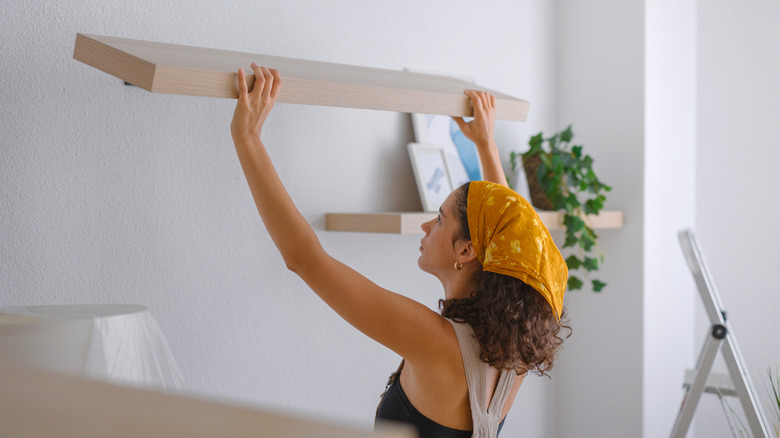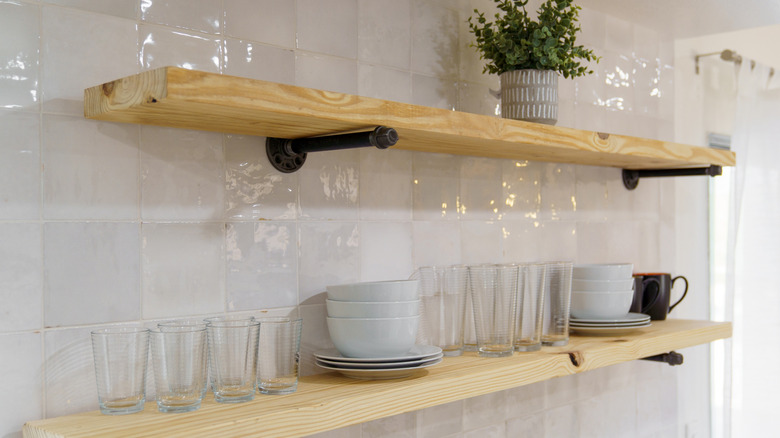What Is The Most Reliable Kind Of Floating Shelf Hardware?
Floating shelves may not appear sturdy since they are suspended on the wall from only one side, but if installed right, they can hold most objects without any problem. The key to this is using the right hardware. There are two reliable options to use to secure a floating shelf and ensure it can handle the weight of the objects placed above it. The first is a metal bracket system with a set screw, which will require drilling through the shelf and into the support rods inside. The other is silicone adhesive, which is more straightforward since you only need to apply the adhesive to the support rods before inserting them into the shelf. Although both serve the same purpose of stabilizing the shelf onto the wall-mounted support rod and metal bracket system, one appears to be able to handle more weight than the other. As such, it can be used in DIY floating shelves that are strong enough to hold kitchen supplies, books, and other heavy items.
A floating shelf with screws attached to wall studs can support about 45 to 50 pounds per stud that the shelf bracket is fastened to. This translates to 100 pounds for a shelf with two wall studs. There's no rigid information on the weight capacity of floating shelves that use adhesives, but it can be assumed that they can carry less weight since the structural connection formed between the rod and the shelf bracket may not be as secure. However, this is purely subjective since some heavy-duty glues can be even stronger than screws.
Other floating shelf hardware to consider
Aside from metal bracket systems with either set screws or silicone adhesives, other hardware options are available for mounting floating shelves. One reliable alternative is a French cleat system, which is composed of two interlocking angled wood or metal pieces. One is attached to the wall using screws, and the other to the back of the floating shelf. The two will create a tight, secure mount when joined together. A benefit of this hardware option is that it's easy to remove if needed. Another reason to choose this over the other options is it can hold substantial weight — so much so that there are many French cleat tool holder ideas for DIY enthusiasts.
If you are not so determined to have the floating shelves appear suspended mid-air against the wall, standard shelf brackets will do a fine job mounting the shelves and keeping them steady. Since these do not need to be concealed like the metal bracket system, they are easier to install with just standard screws and plastic anchors. For shelves that are going to carry especially heavy or fragile objects, a combination of toggle bolts and wall anchors is the better option to ensure a stable mount, solid grip, and well-distributed weight across the shelf. Installation requires the insertion of the spring toggles into drilled holes in the wall. Once installed, the spring toggles will open, forming a secure fix from the inside of the wall.
Wall type also affects the weight capacity of floating shelves
There's another factor that DIYers should consider before installing a floating shelf. There's more to a good successful shelf installation than just choosing the best style of floating shelf or determining the perfect material for your floating shelf. The type of wall where you will hang the mounting brackets for the support rods and wall studs matters just as much, if not more. Even when installed with the best hardware, floating shelves can fail if mounted on the wrong wall type. For example, you shouldn't install floating shelves intended to carry heavy objects on drywall, since this material can only support a few pounds of weight. You will need drywall anchors to support anything heavier than that, or you can strategically install the shelf through the studs behind the drywall for a more secure hold.
If you live in a home with plaster walls, installing floating shelves can be challenging since this material is prone to cracking. Aside from using specialized anchors and pre-drilling the holes, you will need to use masonry drill bits to ensure you don't crumble the wall. Plaster is designed to be stronger than drywall, so when done right, your floating shelf should be able to support more weight than it would on drywall. Meanwhile, the most durable wall materials to hold floating shelves with heavy objects are concrete and bricks. Though installation can be labor-intensive and require more advanced skill in handling masonry bits and anchors, it will all be worth it once you start placing more weighty items on your floating shelf.


